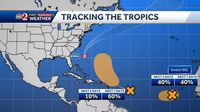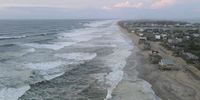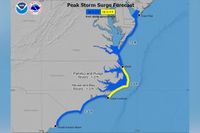As the summer of 2025 draws to a close, the Atlantic hurricane season is making its presence felt in dramatic fashion. Hurricane Erin, the first hurricane and fifth named storm of the season, is churning hundreds of miles off the U.S. East Coast—its powerful winds and massive waves already causing chaos for coastal communities from North Carolina to the Northeast. Meanwhile, meteorologists are keeping a close watch on two additional tropical disturbances in the Atlantic, raising the stakes for what could become a notably active season.
According to the National Hurricane Center (NHC), Hurricane Erin intensified on August 20, 2025, holding steady as a formidable Category 2 hurricane with sustained winds of 110 mph and higher gusts. Erin’s center was located about 335 miles south-southeast of Cape Hatteras, North Carolina, moving north at 13 mph. The NHC warned that further strengthening was likely, with Erin potentially reaching major hurricane status (Category 3 or higher) by Wednesday night. Hurricane-force winds extended outward up to 105 miles from the storm’s center, and tropical-storm-force winds stretched as far as 265 miles, making Erin a broad and dangerous system even without a direct landfall.
While the hurricane’s core was forecast to remain offshore, its impacts were already being felt. The NHC and the National Weather Service (NWS) issued a slew of warnings for the eastern seaboard. A Tropical Storm Warning was in effect from Beaufort Inlet, North Carolina, to Chincoteague, Virginia, including the Pamlico and Albemarle sounds. A Storm Surge Warning, indicating the danger of life-threatening inundation from rising water moving inland, was declared from Cape Lookout to Duck, North Carolina.
"A Storm Surge Warning means there is a danger of life-threatening inundation, from rising water moving inland from the coastline, during the next 36 hours in the indicated locations," the NHC explained, as quoted by Newsweek. The NWS further cautioned that inundation could reach three feet or more above normally dry ground, especially in low-lying areas near the ocean.
Coastal impacts were already being felt on the Outer Banks, with conditions expected to worsen through Wednesday and peak by Thursday. NC-12 and secondary roads on Hatteras and Ocracoke Islands could become impassable due to significant wave run-up, the NWS warned. The NHC also cautioned that the combination of large waves and storm surge could cause extensive beach erosion and overwash, threatening infrastructure and homes along the coast.
Officials in Dare, Hyde, and Currituck counties responded by declaring local states of emergency and issuing mandatory evacuation orders for tourists and residents in vulnerable areas, including Ocracoke Island, Hatteras Island, and the off-road area of Corolla. These measures, effective early Wednesday morning, aimed to protect lives as the threat of coastal flooding and storm-surge inundation loomed.
North Carolina Governor Josh Stein took decisive action, declaring a statewide state of emergency on August 19 to streamline emergency response efforts. "Yesterday, I declared a state of emergency across North Carolina to facilitate our emergency response and to keep you safe," Stein said at a news conference, as reported by FOX Weather. "The statewide state of emergency enables us to send critical resources across the state and around the country to respond." Stein detailed a cross-agency response involving the Department of Public Safety, Department of Transportation, the North Carolina National Guard, the state Highway Patrol, and other local partners. "We have already pre-positioned three swift-water rescue teams and 200 National Guard troops to various locations on the coast, along with boats, high-clearance vehicles and aircraft," he added.
North Carolina Emergency Management Director William Ray issued a stark warning: "Do not drive around barricades and do not drive through flooded waters. You cannot judge the depth or speed of the floodwaters from inside your vehicle." Ray underscored the severe risk posed by the hurricane, noting, "Extremely large, dangerous waves forecasted around 20 feet in height, along with a storm surge of 2 to 4 feet on top of the surf, will likely impact the dunes along portions of the North Carolina coast, especially east- and southeast-facing beaches on the Outer Banks."
The threat to life was echoed by Governor Stein: "When there is a major storm, when there is flooding, there is a great risk of death. And what we don’t want is for people to die." To support evacuees, a State Operated Shelter was opened in conjunction with Warren County Emergency Management.
As Hurricane Erin churned offshore, its massive swells generated dangerous surf conditions up and down the coast. Beach erosion, already a chronic problem in places like Rodanthe, North Carolina, was exacerbated by the storm. Drone footage captured by FOX Weather Storm Tracker Mark Sudduth showed monster waves pounding the shoreline, threatening homes that have withstood years of encroaching tides.
Local officials and lifeguards issued urgent pleas for beachgoers to stay out of the water through Friday, August 22, as powerful rip currents made swimming treacherous. Wrightsville Beach alone saw nearly 80 water rescues in two days due to swimmers caught in rip currents. "These swells are producing powerful rip currents that can create extremely hazardous swimming conditions," said Sam Proffitt, director of Wrightsville Beach Ocean Rescue, to FOX Weather. "The safety of our beachgoers is always our top priority, and we urge everyone to follow this advisory."
The NHC amplified those warnings on social media: "There is a high risk of rip currents from today and on Thursday for most U.S. East Coast beaches from South Florida to Massachusetts due to Hurricane #Erin. Beachgoers are urged to follow information from lifeguards, local authorities, and beach warning flags. The best advice? Stay out of the water!"
ABC chief meteorologist Ginger Zee offered a reminder that hurricanes don’t need to make landfall to pose a threat: "Hurricane #Erin is a great reminder that you don't have to have a landfalling storm to have widespread impacts along the coast. High surf combined with high tide means coastal flooding and erosion as a real concern for beaches all along the east coast, not just the Outer Banks!"
Looking ahead, the NHC forecast Erin to make a gradual turn to the north-northeast on Wednesday before accelerating northeast and east-northeast by Thursday and Friday. The hurricane’s center is expected to remain over the western Atlantic between the East Coast and Bermuda through early Friday, then pass south of Atlantic Canada before the weekend.
But Erin isn’t the only system on the radar. The NHC is also monitoring two additional tropical waves in the Atlantic. The westernmost disturbance, currently producing broad thunderstorm activity, is moving westward between Africa and the Lesser Antilles. It’s expected to enter a more favorable environment for development late in the week or over the weekend, possibly becoming a tropical depression and bringing unsettled weather to the Leeward Islands—areas already soaked by Erin’s outer rainbands last weekend. The path of this system remains uncertain, but it’s one to watch closely.
Further east, a tropical low dubbed Invest 99L sits southwest of the Cabo Verde Islands, just off the coast of western Africa. The NHC indicated that Invest 99L would encounter only marginally favorable conditions for development for about a day, with the possibility of a short-lived tropical depression forming before conditions become less supportive. There remains ample time to monitor this cluster of thunderstorms before it could pose any threat to the Caribbean or the United States. The next two names on the 2025 hurricane list are Fernand and Gabrielle.
With Erin’s impacts already being felt and two more systems in the wings, coastal residents and vacationers alike are being urged to remain vigilant, heed official warnings, and stay informed as the Atlantic hurricane season enters a potentially volatile phase.



